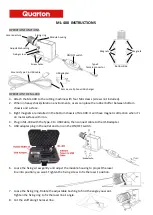
Selecting & Playing Voices
P-85
Owner’s Manual
ENGLISH
18
Selecting & Playing Voices
Selecting Voices
1.
Press one of the voice buttons.
2.
Adjust the volume.
Re-adjust the
[MASTER VOLUME]
slider for the most comfortable listening
level during your performance.
To familiarize yourself with the
characteristics of the voices, lis-
ten to the demo songs for each
voice (page 14).
TERMINOLOGY
Voice:
On the P-85, the term “voice”
means “instrument sound.”
When you select a voice, an
appropriate reverb type will be
selected automatically (page 20).
NOTE
NOTE
Voice Name
Description
Grand Piano 1
Recorded samples from a full concert grand piano. Perfect for classi-
cal compositions as well as any other style that requires acoustic
piano.
Grand Piano 2
Clear piano with bright reverb. Good for popular music.
E.Piano 1
An electronic piano sound created by FM synthesis. Good for pop-
ular music.
E.Piano 2
The sound of an electric piano using hammer-struck metallic “tines.”
Soft tone when played lightly, and an aggressive tone when played
hard.
C.Organ 1
This is a typical pipe organ sound (8' + 4' + 2'). Good for sacred music
from the Baroque period.
C.Organ 2
This is the organ’s full coupler sound, often associated with Bach’s
“Toccata and Fugue.”
Strings
Spacious and large-scale string ensemble. Try combining this voice
with piano in DUAL.
Harpsichord 1
The definitive instrument for baroque music. Since the strings of a
harpsichord are plucked, there is no touch response.
Harpsichord 2
Mixes the same voice an octave higher for a more brilliant tone.
Vibraphone
The sound of a vibraphone played with relatively soft mallets.
16
















































